| |||||
| Decades: | |||||
|---|---|---|---|---|---|
| See also: | |||||
Events from the year 1905 in Russia.
| |||||
| Decades: | |||||
|---|---|---|---|---|---|
| See also: | |||||
Events from the year 1905 in Russia.
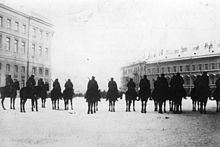


The Russo-Japanese War was fought between the Empire of Japan and the Russian Empire during 1904 and 1905 over rival imperial ambitions in Manchuria and the Korean Empire. The major theatres of military operations were in Liaodong Peninsula and Mukden in Southern Manchuria, and the Yellow Sea and the Sea of Japan.

The Russian Revolution of 1905, also known as the First Russian Revolution, began on 22 January 1905. A wave of mass political and social unrest then began to spread across the vast areas of the Russian Empire. The unrest was directed primarily against the Tsar, the nobility, and the ruling class. It included worker strikes, peasant unrest, and military mutinies. In response to the public pressure, Tsar Nicholas II was forced to go back on his earlier authoritarian stance and enact some reform. This took the form of establishing the State Duma, the multi-party system, and the Russian Constitution of 1906. Despite popular participation in the Duma, the parliament was unable to issue laws of its own, and frequently came into conflict with Nicholas. The Duma's power was limited and Nicholas continued to hold the ruling authority. Furthermore, he could dissolve the Duma, which he did three times in order to get rid of the opposition.
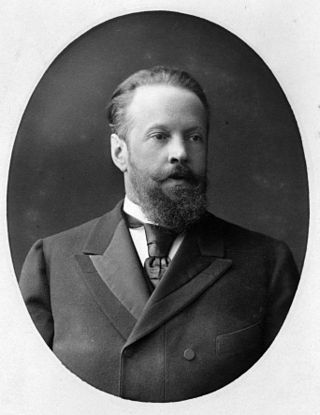
Count Sergei Yulyevich Witte, also known as Sergius Witte, was a Russian statesman who served as the first prime minister of the Russian Empire, replacing the emperor as head of the government. Neither a liberal nor a conservative, he attracted foreign capital to boost Russia's industrialization. Witte's strategy was to avoid the danger of wars.

Zinovy Petrovich Rozhestvensky was a Russian admiral of the Imperial Russian Navy. He was in command of the Second Pacific Squadron in the Battle of Tsushima, during the Russo-Japanese War.
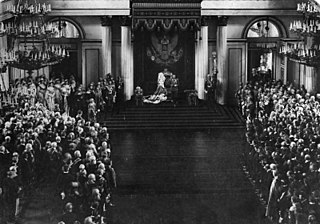
The Russian Constitution of 1906 refers to a major revision of the 1832 Fundamental Laws of the Russian Empire, which transformed the formerly absolutist state into one in which the emperor agreed for the first time to share his autocratic power with a parliament. It was enacted on 6 May [O.S. 23 April] 1906, on the eve of the opening of the first State Duma. This first-ever Russian Constitution was a revision of the earlier Fundamental Laws, which had been published as the Code of Laws of the Russian Empire in 1832. It was granted during the Russian Revolution of 1905, in a last-ditch effort by the imperial government to preserve its own existence and keep the empire from disintegration.

The policy of Russification of Finland was a governmental policy of the Russian Empire aimed at limiting the special status of the Grand Duchy of Finland and possibly the termination of its political autonomy and cultural uniqueness in 1899–1905 and in 1908–1917, fully integrating Finland to the Russian Empire. It was a part of a larger policy of Russification pursued by late 19th–early 20th century Russian governments which tried to abolish cultural and administrative autonomy of non-Russian minorities within the empire.

Under Tsar Nicholas II, the Russian Empire slowly industrialized while repressing opposition from the center and the far-left. During the 1890s Russia's industrial development led to a large increase in the size of the urban middle class and of the working class, which gave rise to a more dynamic political atmosphere. Because the state and foreigners owned much of Russia's industry, the Russian working class was comparatively stronger and the Russian bourgeoisie comparatively weaker than in the West.

Count Vladimir Nikolayevich Lamsdorf was an Imperial Russian statesman of Baltic German descent who served as Foreign Minister of the Russian Empire in 1900–1906, a crucial period which included the Russo-Japanese War and the Russian Revolution of 1905.
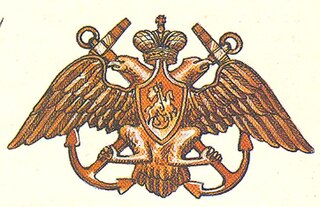
The Imperial Russian Navy operated as the navy of the Russian Tsardom and later the Russian Empire from 1696 to 1917. Formally established in 1696, it lasted until dissolved in the wake of the February Revolution of 1917. It developed from a smaller force that had existed prior to Tsar Peter the Great's founding of the modern Russian navy during the Second Azov campaign in 1696. It expanded in the second half of the 18th century and reached its peak strength by the early part of the 19th century, behind only the British and French fleets in terms of size.
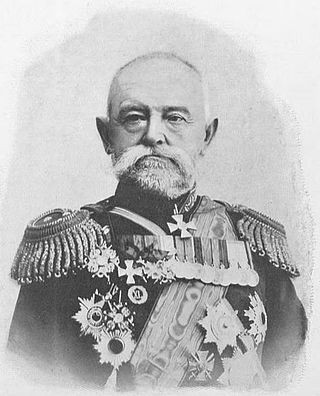
Nikolai Petrovich Linevich, also Lenevich and Linevitch was a career military officer, General of Infantry (1903) and Adjutant general in the Imperial Russian Army in the Far East during the latter part of the Russo-Japanese War.

The State Duma, also known as the Imperial Duma, was the lower house of the legislature in the Russian Empire, while the upper house was the State Council. It held its meetings in the Tauride Palace in Saint Petersburg. It convened four times between 27 April 1906 and the collapse of the empire in February 1917. The first and the second dumas were more democratic and represented a greater number of national types than their successors. The third duma was dominated by gentry, landowners, and businessmen. The fourth duma held five sessions; it existed until 2 March 1917, and was formally dissolved on 6 October 1917.
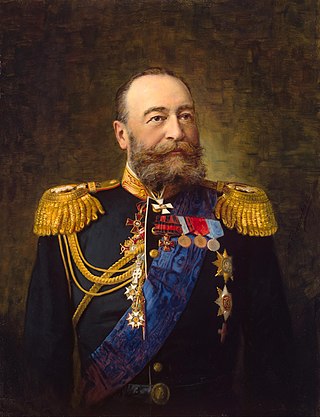
Yevgeni Ivanovich Alekseyev or Alexeyev (Russian: Евге́ний Ива́нович Алексе́ев was an admiral in the Imperial Russian Navy, viceroy of the Russian Far East, and commander-in-chief of Imperial Russian forces at Port Arthur and in Manchuria during the first year of the Russo-Japanese War of 1904-05.
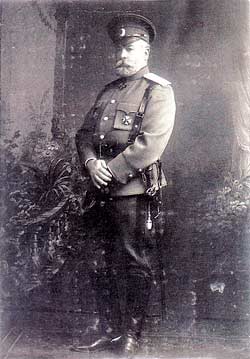
Prince Alexander Bagration, The Prince of Mukhrani was a Georgian nobleman, and head of the princely House of Mukhrani, a collateral branch of the former royal dynasty of Bagrationi and a descendant of Erekle II, the penultimate monarch of the Kingdom of Kartli-Kakheti. A general in the Imperial Russian service and member of the tsar Nicholas II’s immediate circle, he was killed by the Bolsheviks in the post-revolution turmoil in Russia.

The Russian Empire, also known as Imperial Russia or simply Russia, was the final period of the Russian monarchy from its proclamation in November 1721, until its dissolution in March 1917. It consisted of most of northern Eurasia. The empire succeeded the Tsardom of Russia following the Treaty of Nystad. The rise of the Russian Empire coincided with the decline of neighbouring rival powers: the Swedish Empire, the Polish–Lithuanian Commonwealth, Qajar Iran, the Ottoman Empire, and Qing China. It also held colonies in Russian America between 1799 and 1867. Covering an area of approximately 22,800,000 square kilometres (8,800,000 sq mi), it remains the third-largest empire in history, surpassed only by the British Empire and the Mongol Empire; it ruled over a population of 125.6 million people per the 1897 Russian census, the only census carried out during the entire imperial period. It featured great ethnic, linguistic, religious, and economic diversity.

The Coup of June 1907, sometimes known as Stolypin's Coup, is the name commonly given to the dissolution of the Second State Duma of the Russian Empire, the arrest of some its members and a fundamental change in the Russian electoral law by Tsar Nicholas II on 16 June [O.S. 3 June] 1907. This act is considered by many historians to mark the end of the Russian Revolution of 1905, and was the subject of intense subsequent debate as to its legality. It also created a fundamental shift in the makeup of future Dumas in the Russian Empire: whereas previous laws had given peasants and other lower-class people a larger proportion of electors to the Duma, the new law transferred this to the propertied classes, in an effort to avoid election of the large number of liberal and revolutionary deputies who had dominated the First and Second Dumas. Although it largely succeeded in this objective, it ultimately failed to preserve the Imperial system, which ceased to exist during the Russian Revolution of 1917.

Aleksei Alekseyevich Birelev was an admiral in the Imperial Russian Navy, a member of the State Council and Minister of the Navy in the Imperial Government.

Nicholas II or Nikolai II was the last reigning Emperor of Russia, King of Poland and Grand Duke of Finland from 1 November 1894 until his abdication on 15 March 1917. During his reign, Nicholas gave support to the economic and political reforms promoted by his prime ministers, Sergei Witte and Pyotr Stolypin. He advocated modernisation based on foreign loans and close ties with France, but resisted giving the new parliament major roles. Ultimately, progress was undermined by Nicholas's commitment to autocratic rule, strong aristocratic opposition and defeats sustained by the Russian military in the Russo-Japanese War and World War I. By March 1917, public support for Nicholas had collapsed and he was forced to abdicate, thereby ending the Romanov dynasty's 304-year rule of Russia (1613–1917).
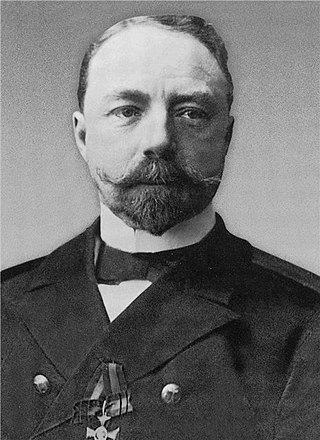
Nikolay Viktorovich Yung was a career officer in the Imperial Russian Navy, noted for his participation in the Battle of Tsushima in the Russo-Japanese War as captain of the battleship Oryol.
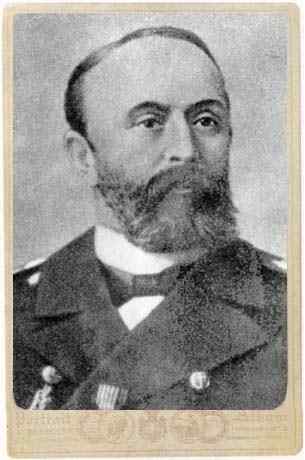
Vsevolod Fyodorovich Rudnev was a career naval officer in the Imperial Russian Navy, noted for his heroic role in the Battle of Chemulpo Bay during the Russo-Japanese War of 1904–1905.
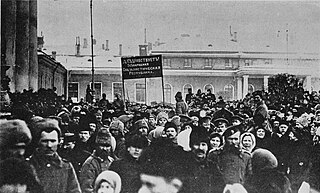
The February Revolution, known in Soviet historiography as the February Bourgeois Democratic Revolution and sometimes as the March Revolution, was the first of two revolutions which took place in Russia in 1917.
![]() Media related to 1905 in Russia at Wikimedia Commons
Media related to 1905 in Russia at Wikimedia Commons